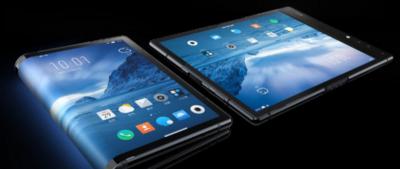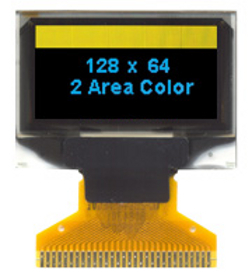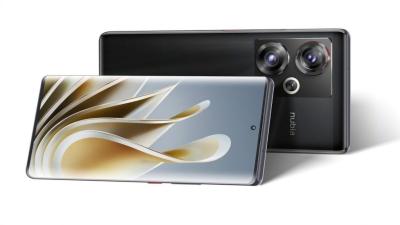OLED displays use organic materials that emit light when electricity is applied. OLEDs enable emissive, bright, thin, flexible and efficient displays - and so OLEDs are set to replace LCDs in all display applications - from small displays to large TV sets.
An AMOLED display is an OLED display that is driven by an active matrix backplane, it is a type of OLED display that can achieve high performance. Most OLED displays such as the ones used in TVs and smartphones are actually AMOLED displays.

What does AMOLED mean?
The term AMOLED means Active-Matrix OLED. The 'active-matrix' part refers to the driving electronics, or the TFT layer. When you display an image, you actually display it line by line (sequentially) as you can only change one line at a time. An AMOLED uses a TFT which contains a storage capacitor which maintains the line pixel states, and so enables large size (and large resolution) displays.
AMOLEDs today
AMOLED displays today are used in many applications - and are most common in smartphones. Most smartphones today use AMOLED displays (over 50% of smartphones use AMOLEDs rather than LCDs), including the latest Samsung phones, and all of Apple's latest iPhone models.
AMOLED displays are also used in OLED TVs, many wearables (such as the Apple Watch), tablets, laptops, VR headsets, monitors, and more. There are also flexible, foldable (and soon rollable) AMOLED displays available today.
AMOLED vs PMOLED
A PMOLED uses a simpler kind of driver electronics - without a storage capacitor. This means that each line is turned off when you move to the next line. So let's say you have 10 rows in your display - each row will only be on 1/10 of the time. The brightness of each row has to be 10 times the brightness you'd get in an AMOLED. So you use more voltage which shortens the lifetime of the OLED materials and also results in a less efficient display. So while PMOLEDs are cheaper to make than AMOLEDs they are limited in size and resolution (the largest PMOLED is only 5", and most of them are around 1" to 3"). Most PMOLEDs are used for character display, and not to show photos or videos.

Looking to buy AMOLED displays?
Are you looking to buy AMOLED display for your project? AMOLEDs on the market range from small 1-inch ones for smartwatches through large OLEDs used in tablets and laptops - to large TV panels, up to 97" in size. Visit our OLED Marketplace, the world's most comprehensive OLED catalog, where you can browse the available panels, and let us help you find the best AMOLED supplier for your needs!
Further reading
Zeekr introduces its 2024 009 MPV, with two OLED displays
China-based EV maker Zeekr introduced the 2024 Zeekr 009 model, a 4/6/7 seater MPV. The new model has two OLED displays: a 15.05" 2.5K flexible OLED main front screen, and a 17" 90Hz 3K ceiling-mounted passenger screen. The 15.05" OLED display seems to be the same display used in the 2024 Zeekr 001 model.
The 2024 Zeekr 009 will feature several seating options, NAPPA leather seats with headrest speakers, ventilation, heating and massage functions, exclusive lounge-chair mode, 30-speaker sound system and high performance - it reach go from 0 to 100 km/h in 3.9 seconds and has a driving range of up to 740Km. Zeekr plans to start delivering the all-new Zeekr 009 to customers in China next week, starting at 439,000 RMB (around $60,000).
Xiaomi announced four new AMOLED devices, including two new foldable smartphones
Xiaomi announced four new devices, all with high-end AMOLED displays. First up we have the Mix Fold 4, a foldable smartphone that has a 7.98" 120Hz 3000 nits 2224x2488 foldable LTPO AMOLED display, and a second 6.56" 120Hz 3000 nits 1080x2520 LTPO external AMOLED display.
Xiaomi's Mix Flip is a clamshell smartphone that offers a 6.86" 120Hz 3000 nits 1224x2912 foldable LTPO AMOLED, with a secondary 4" 120Hz 3000 nits 1392x1204 AMOLED display.
Samsung announces the Z Flip6 and Z Fold6 foldable smartphones, and two new OLED wearables
Samsung announced today four new devices - two foldable smartphones, and two smartwatches, all with AMOLED displays. All of these devices will ship on July 24.
First we have the latest clamshell smartphone, the Galaxy Z Flip6 - that has a foldable 6.7" 120Hz 2,600 nits 1080x2640 LTPO AMOLED display. It also has a 3.4" 720x748 Super AMOLED cover display.
DSCC: demand for AMOLEDs to increase, but the market will remain in oversupply
DSCC says that the AMOLED industry (mainly smartphones and IT applications) is still in oversupply, and this will remain so until 2028 - but demand is expected to increase faster than capacity and so the oversupply will gradually decline to 2028.
Regarding OLED TVs, demand will increase and fab utilization will improve - but in this market DSCC also sees an oversupply situation to 2028 at least (a surplus of 22% in 2028).
LG Display gets approved to supply AMOLEDs for the iPhone 16 Pro Max before Samsung Display
Reports from Korea suggest that Apple approved LG Display as a supplier for its upcoming iPhone 16 Pro Max, the most advanced iPhone model to be released this year. Interestingly, LGD apparently got the approval before Samsung Display, Apple's main OLED supplier.
If true, this is the first time that Apple approves LGD first. This does not necessarily mean anything, but it does mean that the technology gap between Samsung and LGD is low, if present at all. Samsung has much higher production capacity compared to LGD, note. The two companies will likely produce panels for all four iPhone 16 models, and it is reported that BOE will supply some panels for the two standard iPhone 16 models.
Omdia: adoption of OLEDs in smartwatch applications grows to 37% of the market
Omdia says that it expects the global smartwatch display market to reach 359 million units in 2024 (up from 259 million units in 2022). OLEDs hold a 37% market share (132 million units).
Omdia says that the leading smartwatch OLED producers, in the first half of 2024, are LG Display (Apple's main supplier), Everdisplay and Tianma - which together hold a 53% market share. China-based wearable OLED production accounts to 64% of the total market.
Rumors suggest Lenovo is developing a tablet with Samsung's slidable 17-inch AMOLED display
There are some reports that Lenovo is developing a new tablet device that will use Samsung's 17" slidable AMOLED display. The display will be 13" in size when closed, and will be able to roll (slide) up to 17". Lenovo hopes to launch the tablet by 2025.
Back in 2022, Intel demonstrated a laptop device with a 17" rollable AMOLED display, produced by Samsung Display. Since then SDC demonstrated several similar concepts, including a panel that is both foldable and rollable.
Some Apple iPad Pro customers complain of noticeable grain in the new OLED tablets
Earlier this month Apple announced its 2024 iPad Pro devices, Apple's first tablets with AMOLED displays, using tandem panels produced by LG Display and Samsung Displays. Some customers have complained about an annoying grain pattern in the new display:
This is especially noticeable in dark environments. It seems as if the 11" model is more affected by the 13" one. The 11" panel is produced exclusively by Samsung Display, while the 13" is made by both Samsung and LG Display. It could be that this is a problem only at Samsung's panels.
Samsung Display established a dedicated research team to develop OLED products for Apple
According to reports from China, Samsung Display established a new R&D team dedicated to develop OLED products for Apple. The so-called "A Team" is part of the Giheung Research Institute in Yongin, Korea.
This is an interesting move by SDC. Apple is an extremely important customer for Samsung Display, of course, and up until recently SDC has been the leading supplier of OLED displays for Apple - winning the majority of orders for iPhone AMOLEDs. But now that Apple is starting to adopt OLEDs in IT products (starting with tablets) things are changing.
China's small-to-medium OLED production surpasses Korea's for the first time
According to Sino Research, in the first quarter of 2024, small-to-medium AMOLED production in China surpassed the production in Korea, by shipments, for the first time. China's market share was 53.9%, an increase from 44.9% in Q4 2023.
The leading producer is still Samsung Display, with a 41% market share (down from 53.3% last year). BOE has a market share of 17%, Visionox 12%, CSoT 10%, Tianma 9% and LGD 6%. The mean reason for the rise in China production and a decline in Korea's is lower shipments to Apple and an increase in the adoption of OLEDs in Chinese smartphones.
Pagination
- Page 1
- Next page









